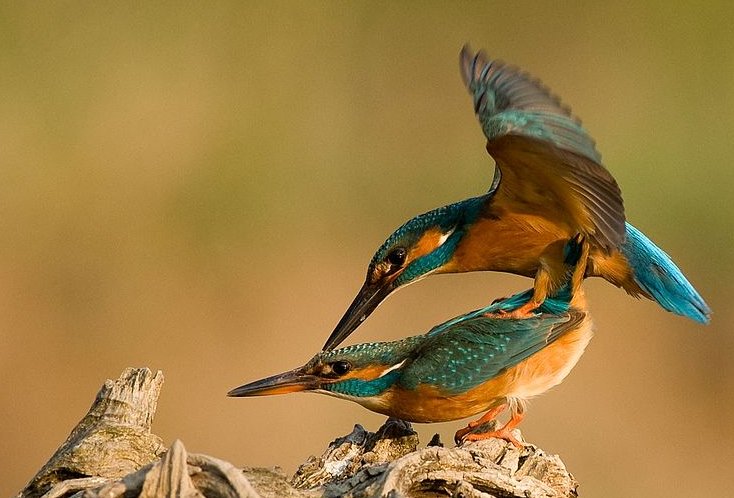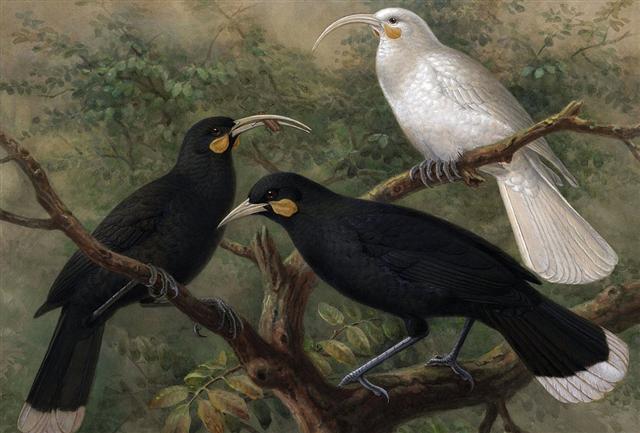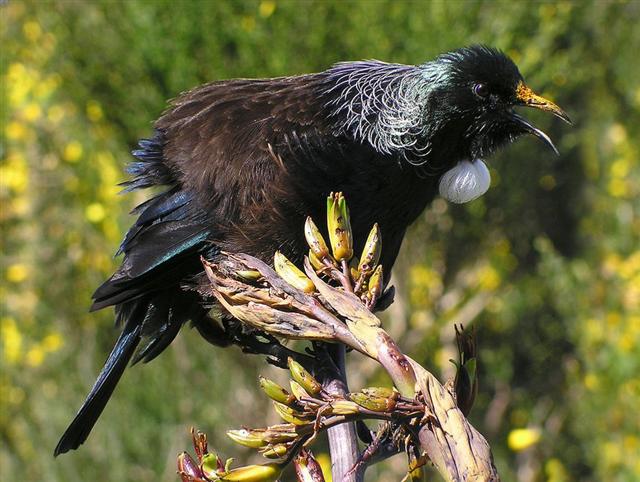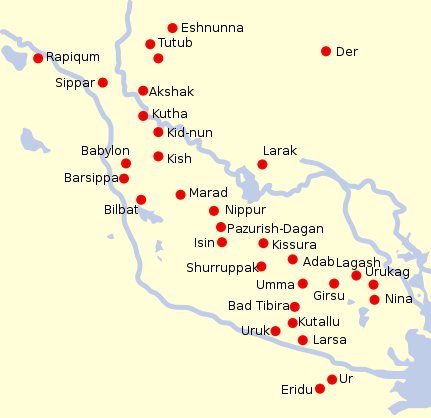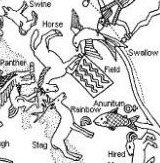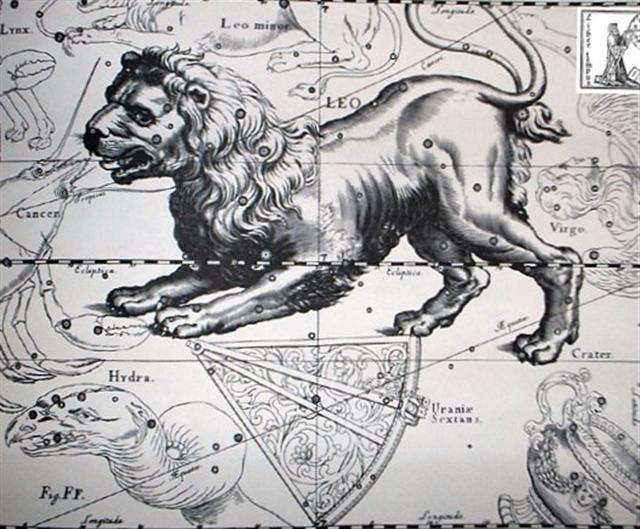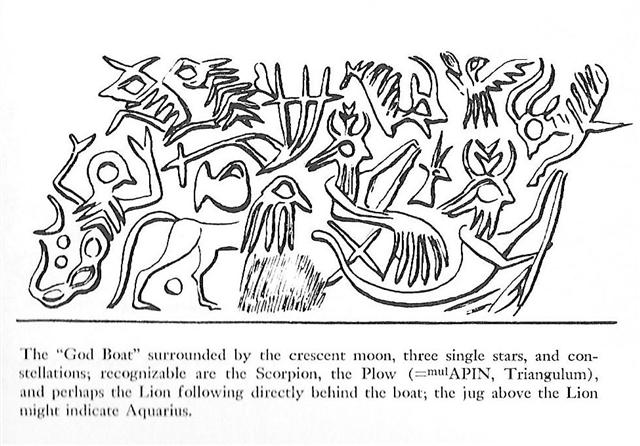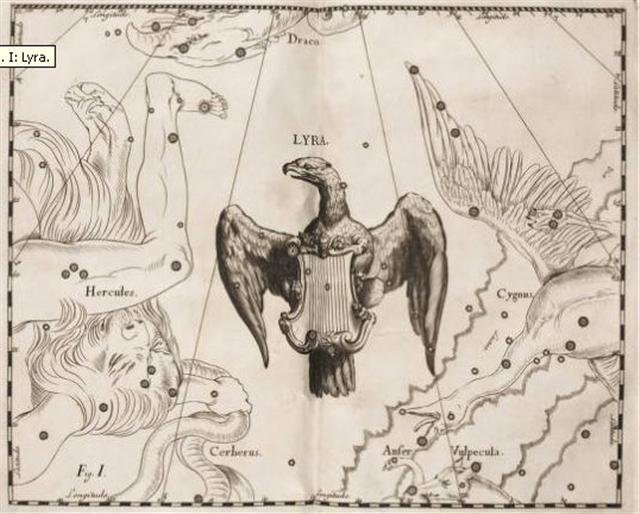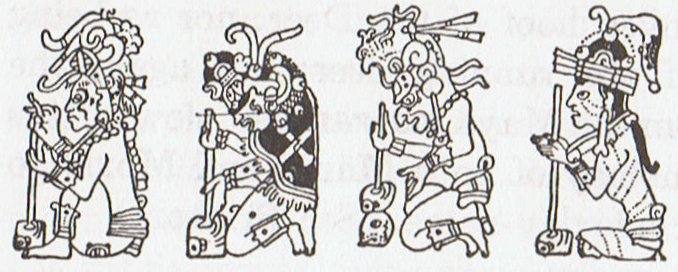Perhaps the 6 Pleiades women at the end of side b on the G tablet marked where the king was being prepared (dressed, puo)
for his glorious return (at the horizon in the east): "Glory-hole ... cell to which prisoners are brought on the day of trial; (colloq.) receptacle for a disorderly collection of things; (techn.) small furnace in which goods are reheated in glass-making ..." (English Etymology)
The pair of nude women - one oriented withershins and crouching below (Hurin), the other one (Hanan) following behind the King - could possibly allude to Alcyone and Pleione, in which case the central man dressed up in his finery would be Atlas - culminating in December 31. ... in the ceremonial course of the coming year, the king is symbolically transposed toward the Lono pole of Hawaiian divinity ... It need only be noticed that the renewal of kingship at the climax of the Makahiki coincides with the rebirth of nature. For in the ideal ritual calendar, the kali'i battle follows the autumnal appearance of the Pleiades, by thirty-three days - thus precisely, in the late eighteenth century, 21 December, the winter solstice. The king returns to power with the sun. Whereas, over the next two days, Lono plays the part of the sacrifice. The Makahiki effigy is dismantled and hidden away in a rite watched over by the king's 'living god', Kahoali'i or 'The-Companion-of-the-King', the one who is also known as 'Death-is-Near' (Koke-na-make). Close kinsman of the king as his ceremonial double, Kahoali'i swallows the eye of the victim in ceremonies of human sacrifice ... In the deep night before the image [of Lono] is first seen, there is a Makahiki ceremony called 'splashing-water' (hi'uwai). Kepelino tells of sacred chiefs being carried to the water where the people in their finery are bathing; in the excitement created by the beauty of their attire, 'one person was attracted to another, and the result', says this convert to Catholicism, 'was by no means good'. At dawn, when the people emerged from their amorous sport, there standing on the beach was the image of Lono. White tapa cloth and skins of the ka'upu bird hang from the horizontal bar of the tall crosspiece image. The ka'upu is almost certainly the albatross, a migratory bird that appears in the western Hawaiian chain - the white Lanyon albatross at Ni'ihau Island - to breed and lay eggs in October-November, or the beginning of the Makahiki season ...
The lost Pleiad married a mortal: ... As soon as one has mastered the elementary grammar and accidence of myth, and built up a small vocabulary, and learned to distinguish seasonal myths from historical and iconotropic myths, one is surprised how close to the surface lie the explanations, lost since pre-Homeric times, of legends that are still religiously conserved as part of our European cultural inheritance. For example, the various legends of the halcyon, or kingfisher which like the wren, is associated in Greek myth with the winter solstice.
There were fourteen 'halcyon days' in every year, seven of which fell before the winter solstice, seven after, peaceful days when the sea was smooth as a pond and the hen-halcyon built a floating nest and hatched out her young. According to Plutarch and Aelian, she had another habit, of carrying her dead mate on her back over the sea and mourning him with a peculiarly plaintive cry. The number fourteen is a moon-number, the days of the lucky first half of the month; so the legend (which has no foundation in natural history, because the halcyon does not build a nest at all but lays its eggs in holes by the waterside) evidently refers to the birth of the new sacred king, at the winter solstice - after his mother, the Moon-goddess, has conveyed the old king's corpse to a sepulchral island. Naturally, the winter solstice does not always coincide with the same phase of the moon, so 'every year' must be understood as 'every Great Year', at the close of which solar and lunar time were roughly syncronized and the sacred king's term ended ... ... Pliny, who carefully describes the halcyon's alleged nest - apparently the zo÷phyte called halcyoneum by Linnaeus - reports that the halcyon is rarely seen and then only at the winter and summer solstices and at the setting of the Pleiades. This proves her to have originally been a manifestation of the Moon-goddess who was worshipped at the two solstices as the Goddess of alternatively Life-in-Death and Death-in-Life - and who early in November, when the Pleiades set, sent the sacred king his summons to death ...
"Halcyon ... bird fabled to breed on the sea. xiv (alceon, Gower). - L. halcyon, alcyon - Gr. alkuōn kingfisher (halkuōn by assoc. with hάls sea and k˙ōn conceiving, rel. to L. alcēdō ..." (English Etymology) From Temennu (the Babylonian 'Foundation Stone', *56) - i.e. from (H)alcyone - to *95 at the Babylonian 'Back of the Mouth of the Twins' (η Gemini, Tejat Prior, the left foot of Castor still half down in the water) - i.e. to Canopus - there were 7 + 32 = 39 days.
When the Royal Double Canoe was loaded with all the necessities it took them 6 days. The last item mentioned was 500 prisoners, which might have referred to the 'glory-hole' of May 15 (135 + 365 = 500). ... Matua [A Taana] said to Hotu [A Matua], 'Take along the Hanau Eepe and let them work the land!' Hotu called out to Heke: 'Go and bring the 500 prisoners on board the canoe!' He took all of them along, led them on board the canoe, and left them there. For six days (po ono), mats (moenga) were taken on board the canoe (i.e., the loading of the canoe took six days) ... [E:73-74] My idea is supported by how po ono (six nights - not days) were needed, i.e. six moega women). Moe. To sleep, to lie at full length, to dream, to brood, to place, to cohabit; moe atu, to leave off, to desist; moe atu ra, to adjourn, to postpone; moe hakahepo, to talk in the deep; moe aherepo, somnambulist, sleepwalker; moe hakataha, to sleep on the side; moe no, to oversleep, concubinage; moe tahae, to be a light sleeper; moe tahaga, a sleeper; moe vaeahatu, moe hakaroa, to sleep sprawling; rava moe, to sleep sound; ariga moe ki raro, to lie flat on the ground; tae moe, bachelor; hakamoe, to brood, to fold the wings; to reserve, to lay up; to struggle. P Pau.: moe, sleep. Mgv.: moe, sleep, to lie down, coitus, to shut the eyes. Mq.: moe, to sleep, to lie down; haßmoe, to set down on the ground. Ta.: moe, to sleep, to lie down. Moea raruga, lying flat. Moeaivi, thin. Mq.: ivi, haßivi, id. Ta.: ivi, id. Moega, mat. Pau.: moehega, bed. Mgv.: moega, a sleeping mat. Mq.: moena, moeka, mat, floor cloth, bed. Ta.: moea, bed. Moemata, to sleep with the eyes open; mea moemata, phantom. Moemoea, a dream, vision; tikeahaga moemoea, apparition by night. T Mgv., Mq., Ta.: moemoea, dream. Churchill. Mgv. Moemoe, to steal, to purloin at a food distribution. Mq.: moemoe, to seize, to grasp. Churchill. Ta.: 1. Moemoe, ambush. Ha.: moemoe, id. 2. Moemoe, Phyllanthus simplex. To.: mohemohe, a tree. Churchill. Mq.: Moehu, exiled, banished, prisoner of war. Ma.: morehu, a survivor. Churchill. Which in turn will make us remember the Phoenix cycle: ... A sidelight falls upon the notions connected with the stag by Horapollo's statement concerning the Egyptian writing of 'A long space of time: A Stag's horns grow out each year. A picture of them means a long space of time.' Chairemon (hieroglyph no. 15, quoted by Tzetzes) made it shorter: 'eniautos: elaphos'. Louis Keimer, stressing the absence of stags in Egypt, pointed to the Oryx (Capra Nubiana) as the appropriate 'ersatz', whose head was, indeed, used for writing the word rnp = year, eventually in 'the Lord of the Year', a well-known title of Ptah. Rare as this modus of writing the word seems to have been - the W÷rterbuch der Aegyptischen Sprache (eds. Erman and Grapow), vol. 2, pp. 429-33, does not even mention this variant - it is worth considering (as in every subject dealt with by Keimer), the more so as Chairemon continues his list by offering as number 16: 'eniautos: phoinix', i.e., a different span of time, the much-discussed 'Phoenix-period' (ca. 500 years) ...
500 - 245 (September 2) = 255 (= 80 + 135) and 6 + 255 = 261 = 9 * 29: ... Hotu's canoe sailed from Maori to Te Pito O Te Kainga. It sailed on the second day of September (hora nui) ... [E:74]
At the time of Bharani they could have waited for the return of a star to visibility, which as a rule took a minimum of 16 (= 64 / 4) days. When the loading of the Royal Double Canoe was finished in "September 2 (245) it therefore should have corresponded to the position of a star which had been at the Sun 16 days earlier. "September 2 (245) ↔ August 17 (229). 6 days earlier was "August 27 (239) ↔ August 12 (223). We can find this place at the Knot (Ukdah):
They evidently had begun to load the Royal Double Canoe when the ancient north pole star Vega culminated.
This was half a year away from the night when Sirius culminated, and possibly the preceding great star in the illustration below referred to Canopus (6 days earlier). There was an empty place below the tail of the Dog-star where the arrow once had been - it was night and the arrows from the Sun (his rays) were not present.:
... A man had a daughter who possessed a wonderful bow and arrow, with which she was able to bring down everything she wanted. But she was lazy and was constantly sleeping. At this her father was angry and said: 'Do not be always sleeping, but take thy bow and shoot at the navel of the ocean, so that we may get fire.' The navel of the ocean was a vast whirlpool in which sticks for making fire by friction were drifting about. At that time men were still without fire. Now the maiden seized her bow, shot into the navel of the ocean, and the material for fire-rubbing sprang ashore ...
|
||||||||||||||||||||||||||||||||||||||||||||||||||||||||||||||||||||||||||||||||||||||||||||||||||||||||||||||||||||||||||||||||||||||||||||||||||||||||||||||||||||||||||||||||||||||||||||||||||||||||||||||||||||||||||||||||||||||||||||||||||||||||||||||||||||||||||||||||||||||||||||||||||||||||||||||||||||||||||
.jpg)


